Determination of fair price of a bond is called bond valuation. It includes calculation of present value of future interest payments of the bond, which is also referred to as cash flow. The value of the bond upon maturity is also calculated, and it is known as the bond’s par value or face value.
The interest payments and par value of a bond are fixed, which is why the valuation of the bond is used by the investor for determining the rate of interest that is required for a worthy investment in a specific bond.
Just like any other capital or security investment, the fair theoretical value of a bond is present value of steam of cash flows that the bond is expected to generate. Therefore, bond valuation can be determined by discounting the expected cash flows of the bond to its present value with the help of an appropriate discount rate.
Practically speaking, a lot of times the discount rate is obtained via reference to similar instruments, if such an instrument does exist. Then, for given price, different yield measures are calculated.
Students Need to Find Value of Bonds as Well
It is not just the investors who have to worry about calculating the valuation of bond. There are even students who have bond valuation as one of the topics they have to study. In particular, students studying financing will have to deal with problems regarding determination of the value of bonds. Students even get homework and assignment for the same topic. Sometimes, the problems related to the topic can be confusing and overwhelming. This is where online homework help comes to your rescue.
Get the Online Help
Hiring online homework help services is a great solution if you are facing difficulties dealing with problems of bond valuation. You can get professional help from experts anytime anywhere. Eventually, you will be able solve any problem related to the topic with such sort of expert assistance. You can even get help with assignments related to this topic.
Furthermore, experts in financing can also help you with other topics related to financing as well, including mergers and acquisition. If you need online help for mergers and acquisitions, you may refer to ‘Important Things about Mergers and Acquisitions You Must Know’.
Other Factors to Determine Investment in a Bond
When investors want to determine if they should invest in a specific bond, bond valuation is just one of the factors they consider. Other considerations that are important include:
- The creditworthiness of the issuing company. This helps in determining whether a bond is junk or investment grade
- The price appreciation potential of a bond, which is determined by growth prospects of issuing company.
- Present interest rates and whether these rates are expected to increase or decrease in future.
Fundamental Principle of Calculating Bond Value
The central principle of bond valuation is the value of the bond is equal to current value of its probable cash flows. Three steps are involved in valuation process:
- Estimating expected cash flows
- Determining appropriate interest rates that shall be used for discounting cash flows
- Calculating present value of expected cash flows with the help of interest rate or rates determined.
Obtaining Interest Rates That Are Appropriate
The minimum interest rate that should be accepted by an investor is the return for a risk free bond. For an investor in the U.S., this would be a Treasury Bond. For other bonds, like corporate bonds, the yield or rate would be the government security rate along with a premium, which accounts for the extra risks involved with non-Treasure bonds.
Calculating the Value of a Bond
For bond valuation, it is important to find out the present value or PV of the future cash flows of the bond. PV is nothing but the amount that needs to be invested presently for generating future cash flow. Present value is dependent on in interest rated and timing of cash flow. After calculating the PV of individual cash flows, the overall value can be figured out. As the rates change, the discount rate that is used also increases or decreases.
Change in Price of a Bond When It Approaches Maturity Date
The price of a bond moves closer to its par value as it moves closer to the maturity date. With bond valuation, thee scenarios are possible:
- The price declines over time towards its par value if the bond is at a premium
- The price increases over time towards its par value if the bond is at a discount.
- The price remains same if the bond is at par.
The change resulted from a bond approaching its maturity date and discount rate changes can be decomposed by taking net change in price reflecting change in maturity, then adding it to change in discount rate.


